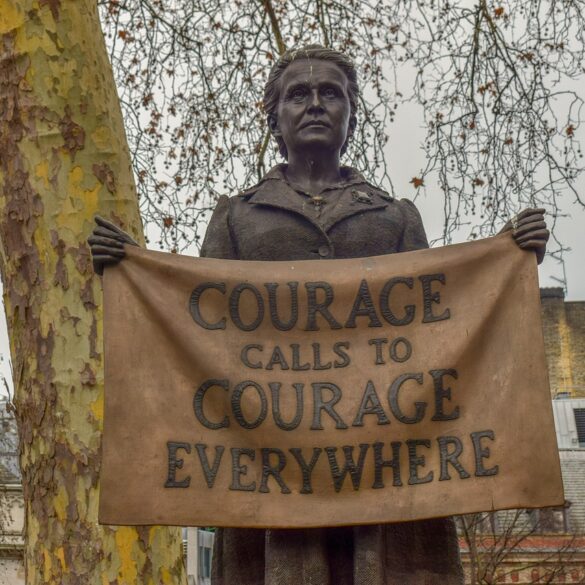Table of Contents
Feminism across different cultures and religions
The concept of feminism transcends geographical boundaries and encompasses diverse cultural and religious perspectives. Feminism, at its core, advocates for gender equality, challenging societal norms and advocating for the empowerment of women. However, the practice and understanding of feminism can vary significantly across different cultures and religions.
This article delves into the complexities of feminism across various cultural and religious contexts, exploring how traditions, beliefs, and societal structures shape the feminist movements within Western cultures, Eastern cultures, and specific religious frameworks such as Islam, Hinduism, Confucianism, and Indigenous cultures.
By examining these different perspectives, we aim to foster a greater understanding of the challenges, progress, and unique contributions of feminism across the globe.
1. Understanding Feminism in a Cultural and Religious Context
Defining Feminism
Feminism, at its core, is the belief in the social, political, and economic equality of the sexes. It is a movement that aims to challenge and dismantle the systemic barriers and inequalities that persist in society, primarily to advance women's rights and achieve gender equality.
The Importance of Cultural and Religious Context
When discussing feminism, it is essential to consider the cultural and religious context in which it operates. Cultural norms and religious beliefs often shape societal expectations, traditional gender roles, and the treatment of women. Understanding these influences allows us to explore how feminism takes shape and evolves across different cultures and religions.
2. Feminism in Western Cultures: Evolution and Key Principles
Historical Overview of Feminism in the Western World
Feminism in Western cultures has a rich and evolving history. It began with the first-wave feminism of the late 19th and early 20th centuries, which focused on securing women's suffrage and legal rights, such as property ownership and divorce. Second-wave feminism emerged in the 1960s, emphasizing gender equality in all aspects of life, including reproductive rights and workplace discrimination. In more recent years, third-wave feminism has pushed for intersectionality, recognizing the diverse experiences and perspectives of women based on race, class, sexuality, and more.
First-Wave Feminism: Suffrage and Legal Rights
First-wave feminism was a pivotal movement that fought for women's right to vote and gain legal recognition. Suffragettes, such as Susan B. Anthony and Emmeline Pankhurst, used nonviolent protests and advocacy to challenge the status quo and secure these fundamental rights for women.
Second-Wave Feminism: Gender Equality and Reproductive Rights
Second-wave feminism expanded the scope of women's rights beyond suffrage. Activists like Betty Friedan and Gloria Steinem focused on issues such as reproductive rights, access to contraception, and challenging gender norms. This wave of feminism brought significant advancements in workplace equality and fought against gender-based violence.
Third-Wave Feminism: Intersectionality and Diverse Perspectives
Third-wave feminism emerged in the 1990s and sought to address the shortcomings of previous waves. It emphasized intersectionality, recognizing how race, class, and other identities intersect with gender to shape women's experiences. Third-wave feminism also embraced various perspectives, fostering inclusivity and giving voice to marginalized communities within the feminist movement.
3. Feminism in Eastern Cultures: Influence of Tradition and Religion
Cultural and Religious Factors Shaping Feminism in Eastern Cultures
In Eastern cultures, cultural and religious factors significantly influence the expression of feminism. Traditional practices, societal norms, and religious doctrines often shape gender roles, creating unique challenges and opportunities for women's empowerment.
Traditional Gender Roles and Expectations
In many Eastern cultures, traditional gender roles assign women primarily domestic responsibilities and caretaker roles, while men are expected to be providers and decision-makers. Challenging these ingrained expectations can be a complex task for feminists seeking to redefine women's roles and push for gender equality.
The Role of Patriarchy and its Impact on Women
Patriarchy, a social system where men hold primary power, is prevalent in many Eastern cultures. It can lead to the marginalization and oppression of women, limiting their access to education, employment, and decision-making processes. Feminism in these cultures often focuses on dismantling patriarchal structures and empowering women to challenge traditional norms.
4. Islamic Feminism: Challenging Stereotypes and Empowering Women
Understanding Islamic Feminism
Islamic feminism is a growing movement within the Islamic world that seeks to reconcile Islamic principles with gender equality and women's rights. It challenges stereotypes about Muslim women by highlighting their agency and advocating for their social, political, and economic empowerment.
Reinterpreting Religious Texts and Practices
Islamic feminists engage in a critical examination and reinterpretation of religious texts and practices to challenge patriarchal interpretations. They highlight verses supporting gender equality and advocate for women's representation in religious institutions.
Advocacy for Gender Equality and Women's Rights
Islamic feminists work towards achieving gender equality within the framework of Islamic teachings. They advocate for women's education, equal rights in marriage and divorce, and the elimination of discriminatory practices. Islamic feminism strives to create spaces where Muslim women can fully participate and thrive while staying true to their faith.
Understanding feminism across different cultures and religions opens up conversations about the complexities of achieving gender equality. It highlights the shared aspirations and diverse experiences of women worldwide, fostering a more inclusive and informed dialogue on women's rights and empowerment.
5. Hindu Feminism: Balancing Tradition and Gender Equality
Feminism within the Hindu Religious Framework
In the realm of Hinduism, feminism has emerged as a powerful force, seeking to strike a balance between tradition and gender equality. While Hinduism is deeply rooted in ancient texts and customs, feminist movements within the religion challenge and reinterpret these traditions to promote gender justice and empowerment.
Exploring Goddess Worship and Female Empowerment
One notable aspect of Hindu feminism is the exploration of goddess worship and its implications for female empowerment. Goddesses such as Durga, Kali, and Saraswati are revered and serve as symbols of strength, wisdom, and creativity. By emphasizing the divine feminine, Hindu feminists argue for the recognition of women's inherent power and worth.
Women's Rights Movements and Activism
Hindu feminism is not confined to spiritual practices alone. Women's rights movements and activism within Hindu communities have also played a significant role in challenging oppressive norms and advocating for gender equality. These movements address issues such as access to education, economic opportunities, and legal rights, aiming to create a more equitable society for all.
6. Confucianism and Feminism: Seeking Harmony and Equality
Confucianism's Influence on Gender Roles
Confucianism, with its emphasis on hierarchy and filial piety, has traditionally prescribed rigid gender roles within societies influenced by its teachings. Women were expected to be obedient, submissive, and dedicated to their families. However, feminism within Confucian societies seeks to challenge and transform these gender norms.
The Evolution of Feminism within Confucian Societies
Over time, feminist movements have arisen in Confucian societies to advocate for gender equality and challenge patriarchal structures. These movements address issues such as gender-based violence, limited educational and career opportunities, and traditional expectations of women's roles. They seek to create a more inclusive society that values the contributions and rights of all individuals, regardless of gender.
Reconciling Tradition with Gender Equality
Reconciling Confucian tradition with feminist ideals is an ongoing challenge. However, many feminist scholars and activists within Confucian societies believe that it is possible to reinterpret and adapt Confucian teachings to promote gender equality. By engaging in dialogue and finding common ground, they strive to create a society where tradition and progressive values can coexist harmoniously.
7. Indigenous Feminism: Uniting Cultural Heritage and Women's Rights
Indigenous Cultures and Their Unique Feminist Perspectives
Indigenous feminism is a powerful force that combines cultural heritage with a commitment to women's rights. Indigenous communities have their own distinct perspectives on gender roles and equality, shaped by their histories, traditions, and connections to the land. Indigenous feminists seek to amplify these voices and challenge colonial and patriarchal systems of oppression.
Matriarchal Traditions and Indigenous Women's Empowerment
Many indigenous cultures have matriarchal traditions, where women hold positions of power and authority within their communities. Indigenous feminism celebrates and builds upon these traditions, advocating for the recognition of women's leadership and autonomy. By reclaiming and revitalizing matriarchal practices, indigenous feminists are empowering women and challenging gender inequality.
Challenges and Resilience in the Face of Cultural Oppression
Indigenous feminism faces unique challenges due to the ongoing impacts of colonization and cultural oppression. Indigenous women often experience multiple forms of marginalization, including racism, sexism, and poverty. However, through resilience, community organizing, and mobilization, indigenous feminists are reclaiming their cultural identities and fighting for the rights and well-being of their communities.
8. Intersectionality and Global Feminism: Building Solidarity across Cultures
As feminism continues to evolve, an understanding of intersectionality has become more prevalent. Intersectional feminism recognizes that individuals can experience multiple forms of oppression based on their intersecting identities, such as race, class, religion, and sexuality. The global feminist movement strives to build solidarity across different cultures and fight for gender equality in all its manifestations.
By acknowledging and addressing the diverse struggles faced by women worldwide, the global feminist movement can create meaningful change. Through cross-cultural dialogue, collaboration, and support, feminists from all backgrounds can work together to dismantle systemic barriers and create a more inclusive, equitable world for all.
In conclusion, the exploration of feminism across different cultures and religions highlights the importance of recognizing the unique challenges and contributions within each context. While there may be variations in approaches and beliefs, the overarching goal of achieving gender equality remains constant.
By understanding and appreciating the diverse perspectives and experiences of feminist movements, we can foster greater solidarity and collaboration in the pursuit of a more equitable world. Through ongoing dialogue and respect for cultural and religious differences, we can work towards a future where feminism is not only a global movement but also one that honors and uplifts the voices and experiences of women from all walks of life.
FAQ
1. Does feminism look the same in every culture and religion?
Feminism is influenced by the cultural and religious contexts in which it emerges. While the core principles of gender equality and women's empowerment remain constant, the expression and priorities of feminism may vary across different cultures and religions. Understanding these variations is crucial to fostering cross-cultural dialogue and collaboration.
2. How does religion impact feminism?
Religion can play a significant role in shaping feminist movements. It can either pose challenges by reinforcing traditional gender roles or offer a platform for reinterpreting religious texts and practices to advocate for gender equality. The relationship between religion and feminism is complex and nuanced, with different religious traditions offering various perspectives on gender and women's rights.
3. Can feminism and cultural traditions coexist?
Feminism and cultural traditions can coexist and even influence one another. Many feminists strive to challenge oppressive practices within their cultures while also preserving and celebrating cultural heritage. The negotiation between feminism and cultural traditions involves finding a balance that respects both equality and cultural diversity.
4. How can feminism bridge across cultures and religions?
Bridging feminism across cultures and religions requires open dialogue, understanding, and respect. Recognizing the unique perspectives and contributions of different cultures and religions can help build solidarity and foster collaborations that address common goals. By embracing intersectionality and seeking common ground, feminism can become a powerful force for positive change across diverse contexts.




